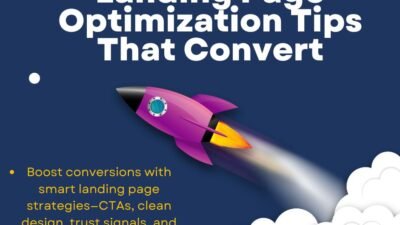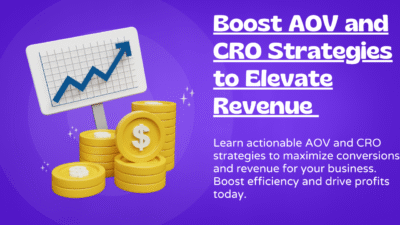Every business, whether small or large, they are always trying to maximize the potential of one’s web site.But how do you turn people who show up into buyers? Simple and powerful–Conversion Rate Optimization (CRO).Creating a seamless online experience that produces real results for your business is one of the most important goals CRO strategies have to achieve.
What Are CRO Strategies?
CRO strategies are tactics and tools used to enhance a website or landing page’s performance to increase the percentage of visitors taking desired actions (conversions). These actions can vary based on business goals, including:
- Purchasing a product
- Filling out a contact form
- Signing up for a newsletter
- Clicking a call-to-action button (CTA)
Instead of simply focusing on driving more traffic to the site, CRO is about making the most of your existing traffic by optimizing it for higher conversions.
Think of it this way. If your current website converts 1 out of every 100 visitors to customers, implementing effective CRO strategies could raise that number to 3, 5, or even more, without additional spending on ads or marketing efforts. Now, that’s efficiency!
Why Do CRO Strategies Matter?
Before jumping into how to craft CRO strategies, it’s essential to understand why they are crucial for businesses today.
1. Maximize Website Traffic Value
Generating traffic through paid ads, SEO, or social media campaigns can be expensive. CRO ensures you get the most out of these investments by converting more visitors into customers, maximizing your return on investment (ROI).
2. Enhance User Experience
By focusing on user behavior, CRO helps improve the overall experience of navigating your website. Whether it’s faster loading times, better-designed CTAs, or simplified checkout flows, happier users lead to higher conversions.
3. Data-Driven Decisions
CRO strategies are rooted in analytics and user insights. This eliminates guesswork and allows businesses to make informed decisions that are backed by real data.
4. Gain a Competitive Edge
Even if you’re driving substantial traffic to your site, your competitors might still outperform you if their site is better optimized for conversions. CRO strategies can help close that gap and give your brand a competitive advantage.
Top CRO Strategies to Drive Conversions
Now that you understand what CRO strategies are and why they’re important, it’s time to explore how to implement them effectively. Below are some proven strategies to boost your website’s conversion rates.
Optimizing Landing Pages
A landing page is often the first interaction visitors have with your brand. Making a great first impression here is critical.
Tips for Landing Page Optimization:
- Highlight Value Propositions:
Communicate the clear benefits of your product or service upfront on your landing page. For example, include attention-grabbing headlines or bulleted lists that explain your offering.
- Use Eye-Catching CTAs:
Make your calls to action (CTAs) stand out with bold colors, compelling text, and strategic placement on the page. For example:
– Weak CTA: “Submit”
– Strong CTA: “Get My Free Report Now!”
- Simplify Forms:
If you’re asking visitors to fill out a form, keep it as short as possible. Only request essential information.
- A/B Testing:
Test different versions of your landing page to identify what style, headlines, CTAs, or images work best for achieving conversions.
Leveraging Data and Analytics
Effective CRO strategies rely heavily on analyzing user behavior to identify problem areas.
Key Tools for Data Collection:
- Google Analytics:
Track website traffic sources, bounce rates, and user behavior flow.
- Heatmaps (e.g., Hotjar):
Visualize how users interact with your webpage by tracking clicks, scrolls, and hover patterns.
- Session Recordings:
Watch real-time recordings of website visits to understand user pathways, pain points, and drop-off reasons.
Website Speed Optimization
Nobody likes a slow website. Studies show that a delay of even a single second in page load time can lead to a significant drop in conversion rates.
How to Speed Up Your Site:
- Compress images to reduce file sizes without losing quality.
- Minify your website’s CSS, JavaScript, and HTML files.
- Use a Content Delivery Network (CDN) to improve loading times for global audiences.
- Optimize your hosting provider for reliability and speed.
Simplify Your Navigation
Complex navigation structures can confuse users and cause them to abandon your site. Ensure your website’s menu is straightforward and guides users intuitively to the desired sections.
Navigation Best Practices:
- Use clear labels for menu items.
- Ensure the search bar is easily accessible.
- Include quick links to popular pages or products.
Personalization
Personalization is the key to creating a seamless and engaging user experience. By tailoring content to match user interests or behaviors, you’re more likely to nurture leads into conversions.
Examples of Personalization:
- Product recommendations based on browsing history.
- Dynamic headlines for repeat visitors (e.g., “Welcome back, [Name]!”).
- Custom email campaigns based on past interactions.
Optimize for Mobile Users
With mobile devices driving over half of all global web traffic, optimizing for mobile isn’t optional anymore; it’s a necessity.
Tips for Mobile CRO:
- Use responsive design to ensure your site looks great on any device.
- Speed up loading times specifically for mobile users.
- Simplify forms further with features like dropdown menus and autofill.
Build Trust and Credibility
Visitors are more likely to convert if they trust your website and business. Building credibility can make all the difference.
How to Establish Trust:
- Display customer reviews and testimonials prominently.
- Include trust badges or certifications, such as “Secure Payment Powered by [Payment Processor].”
- Add detailed contact information and an “About Us” page.
Run Retargeting Campaigns
Retargeting isn’t considered part of CRO by its traditional definition, but it complements optimization efforts by re-engaging visitors who didn’t convert on their first visit. Use retargeting ads to remind potential customers about what they left behind or introduce them to valuable content.
Measuring and Tracking CRO Success
Understanding the impact of your CRO strategies requires tracking the right metrics and KPIs (Key Performance Indicators). To gauge success, consider monitoring:
- Conversion Rate:
Percentage of website visitors completing the desired action.
- Bounce Rate:
Percentage of visitors leaving your site without exploring further.
- Average Time on Page:
Indicates engagement levels.
- Customer Lifetime Value (CLV):
Measures the revenue a customer brings in over their lifetime with your business.
Start Optimizing Today
By utilizing CRO strategies visitors are transformed into customers and your bottom line will increase a lot at the same time.
Start small, with individual pages or features, and gradually scale up based on the data you collect. Make sure everything works before it’s too late.
Are you ready to unlock your website’s potential? With a combination of data, creativity and proven CRO techniques, create a user experience that is without equal. Experiment, refine, and watch your sales conversion rate soar.





